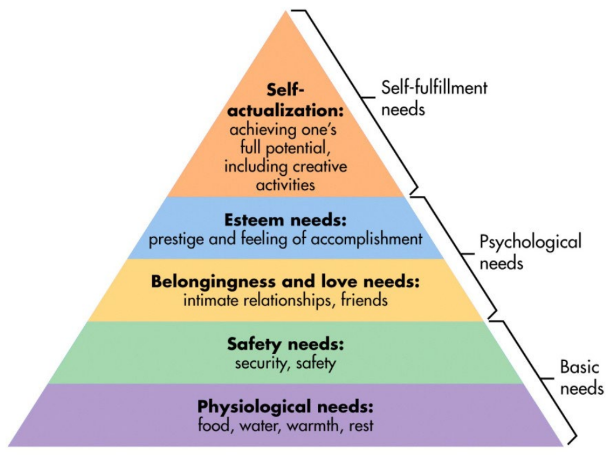Topic 7 slides, group dynamics
Group Dynamics in HCI
Definition of Groups
Groups: Any collection of people who define themselves as a group, governed by shared attitudes and behaviors.
Examples include:
Friends in neighborhoods
Classmates in schools
Colleagues at work
Members of online communities
Group Definitions
Any collection of people who define themselves as a group and whose attitudes and behaviors are governed by the norms of the group.
Notable definitions include:
"What matters is a sense of belonging" [Tajfel, 1981]
"A group exists of two or more individuals perceiving themselves as members of the same group" [Brown, 1995]
"A group exists if its existence is recognized by at least another person" [Turner, 1981]
Characteristics of groups:
Shared goals
Interdependence
Interactions
Mutual influence
Maslow's Hierarchy of Needs
Self-Actualization: Achieving full potential, including creative activities.
Esteem Needs: Prestige and accomplishments.
Belongingness and Love Needs: Intimate relationships and friendships.
Safety Needs: Security and safety.
Physiological Needs: Food, water, warmth, rest.

Need to Belong
According to Baumeister & Leary (1995), the need for bonds aids survival:
Keeping children close to caregivers.
Mutual protection within groups.
Cooperation in hunting and sharing food.
Division of labor to allow growing food.
Emotional support to get through crisis.
Reasons for Joining Online Groups
Alleviation of loneliness.
Attraction of relative anonymity.
Seeking like-minded people.
Remote communication possibilities.
Presenting a 'version' of oneself.
Formation of multinational groups [various studies cited].
Stages of Group Formation [Tuckman, 1965]
Forming: Members introduce themselves; exploration of group's purpose.
Storming: Conflict phase; establishment of hierarchy and role definition.
Norming: Development of cohesion, trust, shared norms, and emotional investment.
Performing: Focus on objectives and insights leading to effective activity.
Adjourning: Conclusion of group activities and dealing with loss.
Group Identity
Social Identity: Self-concept tied to group membership, encompassing its values and emotional significance [Tajfel, 1978].
Collective Identity: Shared similarities and psychological connection with the social group [Abrams & Hogg, 2001].
Building Membership Attachment [Ren et al., 2012]
Importance of developing interpersonal bonds and group identity in online communities.
Affect Generalization: Affection towards one group member can extend to the whole organization.
Two types of attachment:
Bond-based attachment: Focus on individual relationships.
Identity-based attachment: Focus on the group as a whole.
Social Identity Theory (Tajfel & Turner, 1986)
Automatic categorization of people on exterior characteristics.
Ingroup bias towards own members:
Give higher rewards.
Show more prosocial behavior.
Experience more positive affect.
Judge products more favorable.
Implicit Bias
Implicit Association Test (IAT) measures attitudes and beliefs that people may be unwilling or unable to report.
Media Equation and Computers as Social Actors [Reeves & Nass, 1996]
We treat computers as social actors, mainly because we cannot fully understand what is happening.
Effects are stronger with robots, because they act autonomously and simulate emotions.
Group Decision Making: Benefits and Drawbacks
Benefits:
Generate more ideas and solutions.
Objective analysis, multiple perspectives.
Feeling that a group decision is superior to individual decision
Drawbacks:
Group polarization.
Common knowledge effects.
Social influence.
Groupthink.
Groupthink [Irving Janis, 1982]
A kind of thinking in which maintaining group cohesiveness and solidarity is more important than considering the facts in a realistic manner.
Symptoms include:
Illusion of invulnerability
Illusion of morality
Collective rationalization
Excessive sterotyping
Self-censorship
Illusion of unanimity
Pressure for conformity
Mindguards
Preventing Groupthink
Encourage critical evaluation and avoid premature leader preferences.
Utilize subgroups and engage outside opinions.
Create an environment fostering fresh ideas.
Computer-Mediated Communication (CMC) as a Solution
CMC can alleviate the influence majority has over minorities, encouraging dissenting voices, particularly in individualistic cultures [Tan et al., 1998].